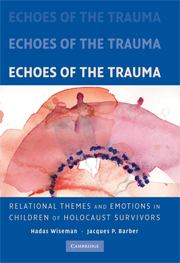Book contents
- Frontmatter
- Contents
- Foreword by Dan Bar-On
- Preface
- Acknowledgments
- 1 Introduction – A Narrative Approach to Bridging the Gap between Clinical Case Studies and Empirical Research on Children of Holocaust Survivors
- 2 Studying Relationship Narratives with the Core Conflictual Relationship Theme Method
- PART ONE RELATIONAL THEMES IN THE NARRATIVES
- PART TWO EMOTIONS IN THE NARRATIVES
- 6 Anger
- 7 Guilt, Shame, and Embarrassment
- 8 Anxiety and Helplessness
- 9 Loneliness
- 10 Joy and Pride
- PART THREE HEALING TRAUMA IN THE CHAIN OF THE GENERATIONS
- Appendix
- References
- Index
10 - Joy and Pride
Published online by Cambridge University Press: 29 July 2009
- Frontmatter
- Contents
- Foreword by Dan Bar-On
- Preface
- Acknowledgments
- 1 Introduction – A Narrative Approach to Bridging the Gap between Clinical Case Studies and Empirical Research on Children of Holocaust Survivors
- 2 Studying Relationship Narratives with the Core Conflictual Relationship Theme Method
- PART ONE RELATIONAL THEMES IN THE NARRATIVES
- PART TWO EMOTIONS IN THE NARRATIVES
- 6 Anger
- 7 Guilt, Shame, and Embarrassment
- 8 Anxiety and Helplessness
- 9 Loneliness
- 10 Joy and Pride
- PART THREE HEALING TRAUMA IN THE CHAIN OF THE GENERATIONS
- Appendix
- References
- Index
Summary
Within the Core Conflictual Relationship Theme (CCRT) framework it is a common observation that the relationship episodes (REs) that are told spontaneously in the course of psychotherapy sessions, or upon request in Relationship Anecdotes Paradigm (RAP) interviews, have a higher frequency of mainly negative rather than mainly positive CCRTs (Luborsky & Crits-Christoph, 1998; see also Chapter 2). A positive CCRT means the narrator has described an interpersonal event in which there was no interference (or no expectation of interference) with the satisfaction of his or her wishes, or a sense of mastery of being able to deal with one's wishes. For example, the wish to be loved is satisfied by another person who is affectionate [positive response of other (P-RO)] and the self feels accepted and happy [positive response of self (P-RS)]. In contrast, a negative CCRT means that the narrator describes an interpersonal event in which there was interference with the satisfaction of his or her wishes (or this is expected to occur). For example, the wish to be loved is unsatisfied by the response from an other that is rejecting [negative response of other (N-RO)] and the self feels frustrated and angry [negative response of self (N-RS)].
In our study, the instructions of the RAP interview that we used asked the interviewee to tell a relational narrative “about a specific event that was personally important or a problem to you in some way” (Luborsky, 1998a; p. 110).
- Type
- Chapter
- Information
- Echoes of the TraumaRelational Themes and Emotions in Children of Holocaust Survivors, pp. 170 - 186Publisher: Cambridge University PressPrint publication year: 2008

